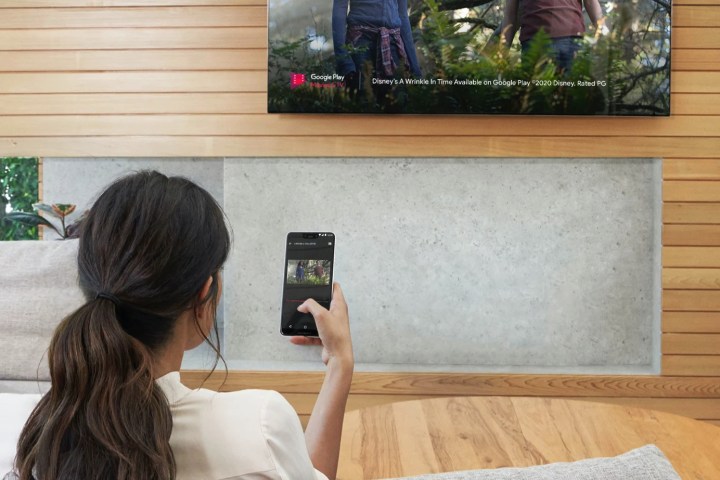While booking a room for the weekend at a favorite destination can be a welcome retreat, there are a few amenities you may be disappointed to find your room doesn’t come with. The absence of a microwave or kitchenette can be a nuisance, as well as various toiletries, but then there’s the lack of available streaming media, too. Many hotels only offer basic cable for guests, leaving many of us without access to our treasured Netflix or Hulu subscription. Fortunately, if you’ve got your hands on a Google Chromecast or a Chromecast with Google TV, you can overcome this shortcoming pretty easily. Here’s how.

Connect the Chromecast to the TV
This first step is critical. The TV in your hotel room has to have an open HDMI port that you can access (many of them don’t), otherwise it’s game over. While you’re looking, take note to see if there’s already an HDMI cable plugged into the TV. If there is, you might need to unplug it in one of the next steps. Once a free port has been found, plug your Chromecast in.
Step 1: Check the sides of the TV, or if you can access it, around the back. The inputs should be clearly labeled as HDMI 1, HDMI 2, etc.
Step 2: Plug your Chromecast into the HDMI port. It doesn’t really matter which one — just make a note of whether it’s HDMI 1, HDMI 2, etc.
Step 3: Plug the power cable into your Chromecast, and the other end into the wall wart. (It’s possible the TV’s USB port may work. Or it may not if it doesn’t provide the Chromecast enough juice.)
Pro tip: bring an extra-long USB power cable in case there isn’t a free wall outlet near the TV.
Step 4: Change the input on the TV to match the one you plugged the Chromecast into. (You remembered to remember, right?)
If you’re successful, you should see the default Chromecast setup screen. If you have trouble switching inputs (maybe because the TV simply won’t allow it), it’s time to try plan B. If you found a cable already plugged into an HDMI port in step 1, unplug it, and swap in your Chromecast. Of course, this means you’ll lose your hotel TV channels, but you can always swap it back once you’ve finished bingeing Stranger Things.
Keep in mind that many hotel chains will purchase HDTVs that are connected to the hotel’s own media servers. In many cases, this means that the HDMI ports on the TV may be locked. So even if there are one or two ports available to connect your Chromecast into, the inputs themselves may not work. If you run into this issue, there’s a quick workaround you can try.
Look at the back of the TV. If you see a cable that looks like an Ethernet wire connected to the TV, go ahead and disconnect it. This is the data stream wire (or RJ11 cable) that the hotel uses to deliver cable streams to each TV. Once this wire is disconnected, you should be able to use the TV’s HDMI inputs.

Connect to the internet
If you’ve gotten this far, this is (hopefully) the last step. Assuming for a moment that your hotel’s Wi-Fi is a standard setup, you’ll simply need to look for the corresponding network on your phone or tablet and use the provided credentials to connect. If you haven’t done so already, download the free Google Home app from Google Play or the Apple App Store. Then, launch the app and follow the on-screen instructions for setting up your Chromecast on the same Wi-Fi network. Congrats, you’re ready to start casting!
If that doesn’t work, you’ve got some other things to try.
Step 1: Create your own Wi-Fi hot spot.
If you have a Windows laptop, you can share its Wi-Fi connection with both your smartphone and Chromecast.
You can do the same thing on a MacOS laptop, but only if you can connect the laptop to an Ethernet connection in the hotel room, and these are becoming increasingly rare.
Same goes for using your phone as a hots pot. Just keep in mind that if you’ve got limited data, you’ll eat through it pretty quickly when streaming video.

Step 2: Use a travel router — preferably one with a WISP mode.
A travel router offers the most reliable way to create a Wi-Fi access point you can then share with devices in your hotel room. There are plenty of these to be found on Amazon and elsewhere, and they usually cost less than $75. Some require access to an Ethernet jack, however, which as we mentioned above, can be hard to find. A model that can run in WISP (Wireless Internet Service Provider) mode (or bridge mode), will let you sign in to your hotel’s Wi-Fi, and then make that connection shareable as a regular Wi-Fi network, with a name and password of your choosing.
One last thing …
If none of these options work for you, or you simply don’t want to be bothered messing around with HDMI ports and Wi-Fi hot spots, you may not need to bring your Chromecast at all. More and more hotels are beginning to install Chromecast-compatible systems like RoomCast. If your hotel has this, all you need is your phone, tablet, or laptop, and you’re all set.
Editors’ Recommendations




